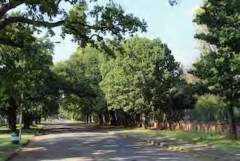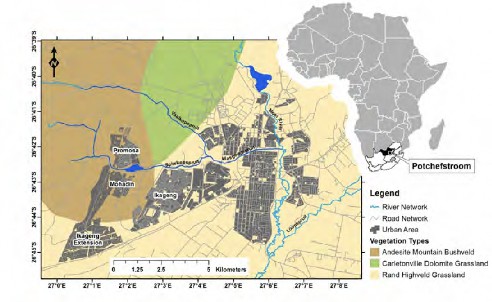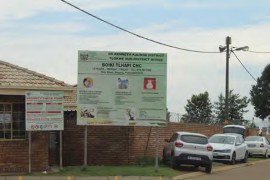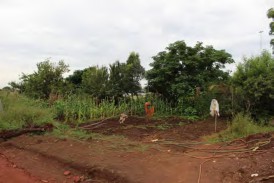Final Report: University of Missouri South African Partnerships Program Proposal: Community Gardens and Indigenous and Local Knowledge
March 1 – March 12 and June 2 – June 14, 2022
Charles Nilon and Andria Caruthers, School of Natural Resources, University of Missouri
Tuesday 1/3
Prof. Sarel Cilliers met us at O.R. Tambo Airport in Johannesburg. We drove two hours southwest to Potchefstroom. We had lunch at a restaurant near NorthWest University and then went to the River View Guest House.

Wednesday 2/3
We spent the day on the NWU campus and at the Catchet Park City Improvement District. We visited the NWU Potchefstroom campus in the morning starting with a look at Oak Avenue, a heritage site in the city recognizing the oak trees planted along the street over 100 years ago. Oak Avenue is also the center of NWU off-campus student life with new student apartments, bars, and stores. Sarel and his students have inventoried the trees on oak street and compiled a data base with information on tree condition, and have worked with the Cachet Park City Improvement District to develop a management plan for the trees.

We toured theNWU campus focusing on the use of native vegetation in landscaping the recently developed engineering campus. We also looked at a tree trail through the central part of the campus and at small greenspaces. These greenspaces featured a small group of vervet monkeys.

In the afternoon we met several of the students working in Sarel’s lab and were introduced to Dr. Nhana Gwedla.
In the late afternoon we visited Cachet Park CID NPC (City Improvement District, Non-Profit Company) https://cachetparkcid.co.za/English/. The CID is a public-private partnership with NWU as a major partner. We met with Johan Naude, the CID general manager and a graduate of NWU, who talked about the work in the park., A key part of the district is managing greenspaces within the CID and reflects the diminished ability of the local council to maintain these species. The CID provides security services with CCTV Cameras, monitoring patrols and guards, refuse removal and recycling, and greenspace management for many of the business and residential areas adjacent to NWU.
Thursday 3/3
At the invitation of Sarel and Prof. Stefan Siebert we gave presentations on some of the ongoing work in the School of Natural Resources. Charlie gave a presentation on research on urban biodiversity and urban wildlife conservation, and an overview of the University of Missouri and the School of Natural Resources to Prof Siebert’s botany class. Later in the morning we gave a public seminar in the NWU library. Prof. Sara Lovell was not able to travel to South Africa, but gave a virtual presentation on the Center for Agroforestry. Andria gave a presentation on her dissertation research on elderberry cultivators.
After lunch we met with Prof. Carlos Bezuidenhoout, Director of the Unit for Environmental Sciences and Management, a position similar to that of a CAFNR Division Director. He is very interested in developing a Memorandum of Understanding with CAFNR that would facilitate collaboration on grants and research, teaching, and potential faculty and student exchanges. He shared a template that NWU uses for MOUs with other institutions.
Universities in South Africa are encouraged to develop these collaborations and project proposals with international collaborators receive additional points in the rating scheme used by the National Research Foundation. Sarel mentioned that he had collaboration with Prof Norbert Mueller, Technical University of Erfurt, Germany for several years that may have been part of a broader MOU.
Friday 4/3
Charlie visited Faan Meintjes Nature Preserve with Ian Luyt, a PhD student at NWU. The focus of the visit was to look at birds as a component of biodiversity in local greenspaces. The preserve is 16 km northwest of Klerksdorp and was developed by the local council in the 1970s but now suffers from a lack of funds to support maintenance. Ian works with Prof.
Henk Bouwman who supervised some urban bird research in Potchefstroom (Smith 1994) in the mid 1990’s. We met briefly with Prof. Bouwman and had initially planned to visit some of the areas studied in the 1994 study but a rainy morning prevented this.
Friday afternoon we drove along several residential streets in Potchefstroom and looked at public and private greenspaces along the Mooi River. The areas we visited were residential areas that had been reserved for white residents under apartheid. One of key issues in Potchefstroom and the surrounding region is the lack of management of greenspaces by local councils. There is a significant amount of planned greenspace, but much of the management of these greenspaces has become privatized with work done by residents or in some cases by individuals or companies hired by residents and businesses.

Saturday 5/3 – Monday 7/3
Saturday, Sunday, and Monday were spent with Sarel visiting Vredefort Dome World Heritage Site, and an overnight visit to Pilanesburg National Park.
Tuesday 8/3
We visited three residential areas: Ikageng (“African” township); Promosa (“Coloured” township); and Mohadin ("Indian” township) that were developed between 1957 and 1971 in Potchefstroom under apartheid relocation policies. Our visit included a fourth residential area that Ikageng Extension, that developed as rural residents moved into the city following the end of apartheid in 1994. We were joined by Sonia, an undergraduate student doing an honors thesis on the health clinic gardens, supervised by Nhana and Sarel. This was our first exposure to Nhana’s research project and we learned how that project is connected to the long-term work that Sarel and his colleagues have done on home gardens and health clinic gardens. Ikageng is typical of townships that were developed during apartheid. It is separated from the “white” areas of the city by a large industrial area with a mix of private homes, newer government built social housing, and a large number of informal settlements. Marie J. Du Toit’s PhD Dissertation (2015) provides a detailed description of the ecological and socioeconomic gradients that shape residential gardens and greenspace in the city.

M.J. Du Toit. 2015
Sonia is assessing the status of health clinic gardens that were identified in an initial survey of 275 health clinic gardens in 2017 (Cilliers 2018). Each assessment will include the presence and condition of the garden, a plant inventory, and a short interview with the garden manager. We looked at gardens in older established neighborhoods as well as informal settlements. There is a tremendous amount of variation among gardens in the residential areas we visited. Some have no vegetation, some have vegetable gardens, some have flowers. Health clinic gardens show similar patterns. We observed some clinics who had removed their gardens, others with large gardens and engaged garden managers. Sarel and Charlie discussed how their planned collaboration might incorporate Nhana’s work and agreed that focusing on the role of decision making by garden managers could be a first step.


Wednesday 9/3
We joined Sarel and Sonia to visit health clinic gardens in Stilfontein (Khuma Clinic, Botshabelo Clinic, Stilfontein City Clinic) and Orkney (Leana Clinic). These clinics were surveyed in the 2018 study. We had an extended conversation with the garden manager of the Stilfontein City Clinic who offered a variety reasons for delays in planting and managing the garden. In the afternoon I talked with Ifeoma (Iffie) Ukonze, Sarel’s PhD student. She is from Nigeria and working on a project studying African cities and green infrastructure. We discussed some of the differences in home and community gardens in South African and Nigerian cities.
Thursday 10/3
We visited Mahikeng, met Nhana, and visited several health clinic gardens. Our original plan was to meet with Prof. Matarechera with the indigenous knowledge program at the NWU Mahikeng campus. Mahikeng is a This was cancelled because a student demonstration closed the campus. We visited three health clinic gardens (Unit 9 Clinic, Montshio-Stadt Health Clinic, Motlhabeng Clinic) in Mahikeng with Nhana . Again, the condition of the garden and the involvement of the clinic staff with the garden varied tremendously. We spent an hour at the end of the visits to discuss ideas for a joint project, and on the types of gardens she might visit during her stay in Columbia in June. Nhana was intrigued by the opportunity to study gardens hosted and sponsored by faith communities , a rare occurrence in South Africa. We agreed to replicate her garden manager survey among organizers faith community gardens in Columbia.
Friday 11/3
We met with Prof. Petra Bester, director of AUTHER (Africa Unit for Transdisciplinary Health Research). Prof. Bester and her staff have collaborated with Sarel on some of his research on gardens because of their focus on indigenous knowledge of local foods. Bester’s work looks at outreach program targeting families to continue to use local foods. She mentioned that use of native plants and traditional foods is often shunned by younger residents of the North-West Province who consider their use to be a legacy of being poor.This was a very interesting visit with a potential partner for collaboration around indigenous knowledge of local foods
Saturday 12/3
We drove from Potchefstroom to the Cradle of Humankind World Heritage Site in Gladysvale and spent the late morning to early afternoon visiting the site with the largest collection of human ancestral remains in the world. We then drove through the northwest suburbs of Johannesburg and were dropped off at O.R. Tambo Airport.
Some observations on our visit to North-West University.
The planned focus on animal biodiversity in health community gardens has the potential to be successful, however that line of research is of secondary interest to Dr. Gwedla who is completing a postdoc at NWU. The first step in our collaboration will be on the survey of garden managers in Columbia. There are good opportunities for collaboration between University of Missouri faculty with faculty in the Environmental Science Unit at NWU on both the Potchefstroom and Mahikeng campuses. There is interest in agroforestry at NWU, and there are opportunities for collaboration on projects involving indigenous knowledge and food. The unit through its director is interested in developing exchanges, joint research opportunities, and other collaborative activities for faculty and students. The research and teaching programs are very similar to those in CAFNR. The Potchefstroom campus is
similar in size to MU and in a similar setting with a nearby student-focused commercial and residential area and a large number of on-campus residences. Although CAFNR appears reluctant to restarting its South Africa Study Abroad Program. NWU would be an excellent location for a program. There are opportunities for a more immersive experience at either campus, opportunities for extensive visiting Pilanesburg National Park and Madikwe Game Reserve.
June 2 – June 14 Nhana Gwedla at University of Missouri
Nhana visited Columbia for 14 days in June. She was interested in looking for opportunities for collaboration in her garden research.
- Nhana met with Profs. Sarah Lovell, Mike Gold, staff, and graduate students in the Center for Agroforestry. She visited the Horticulture and Agriculture Research Farm, met with graduate students to discuss their research, and spent time with Andria learning about her elderberry work, including attending portions of a conference of elderberry producers.
- Nhana presented a seminar hosted by the School of Natural Resources. Faculty and graduate students from the school participated as well as others with an interest in South Africa, including Antionette Landor, a 2022 UM South Africa Program Participant.
- We organized several meetings on urban agriculture and community gardens in Columbia. Nhana met with Adam Saunders (Columbia Center for Urban Agriculture) and Bill McKelvey (MU Extension and Columbia Community Garden Coalition) who provided an overview on what is going on in Columbia and opportunities for collaborative work. Nhana was particularly interested in the role of community gardens hosted by churches. She met with leaders of three faith community gardens: John and Linda Coats (Bethel Baptist Church), Mike Gold and Lily Chan (Columbia Interfaith Garden), and Don Day (Broadway Christian Church). She visited the Columbia Interfaith Garden, and gardens at Bethel Baptist Church, Broadway Christian Church, and Friendship Missionary Baptist Church.
- We met with Kerry Clark to discuss opportunities for collaboration between CAFNR and NWU’s Environmental Science Unit faculty in Potchefstroom and Mahikeng.
Nhana and Charlie agreed to collaborate on a study of faith community gardens and garden managers in 2023.
References
Du Toit, M. J. 2015. An urban ecological synthesis of socio-ecological systems dynamics in Potchefstroom, South Africa. Ph.D. Dissertation, North-West University, Potchefstroom, South Africa.
Cilliers, S. S., S. J. Siebert, M. J. Du Toit, S. Barthel, S. Mishra, A. Cornelius, and E. Davoren. 2018. Health clinic gardens as nodes of social-ecological innovation to promote garden ecosystem services in Sub-Saharan Africa. Landscape and Urban Planning 180:294–307.
Smith, N. 2004. Birds and the urban ecology of Potchefstroom. M.S. Thesis, North-West University, Potchefstroom, South Africa
Reviewed 2025-11-10